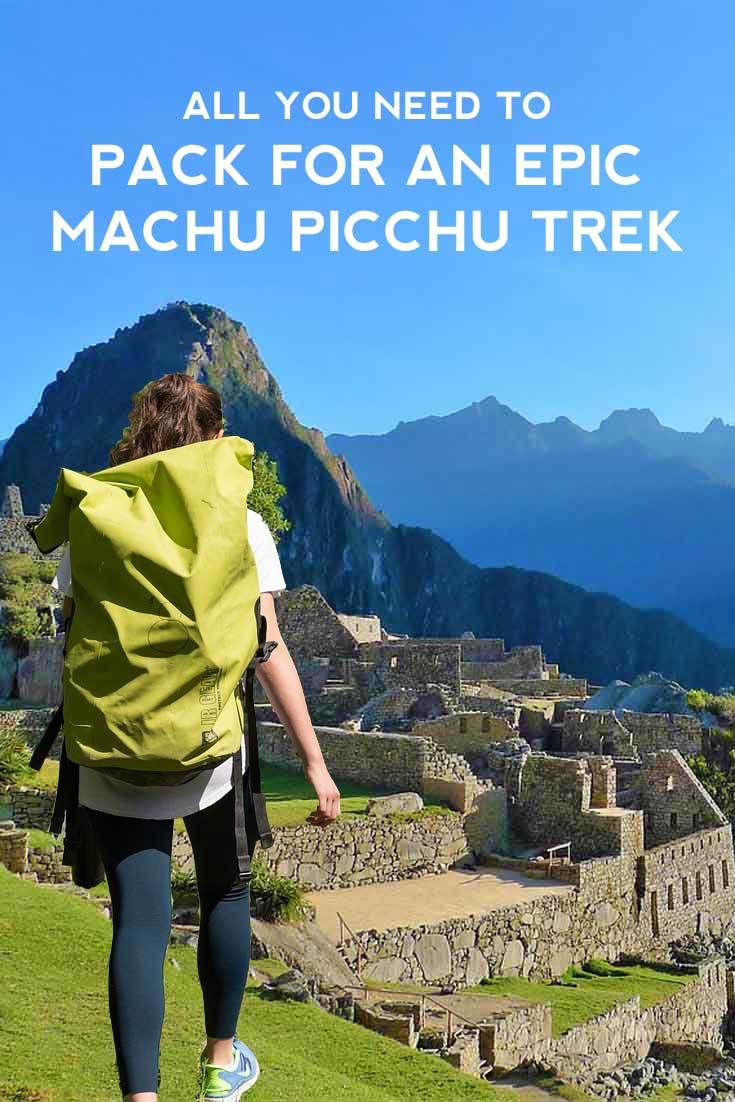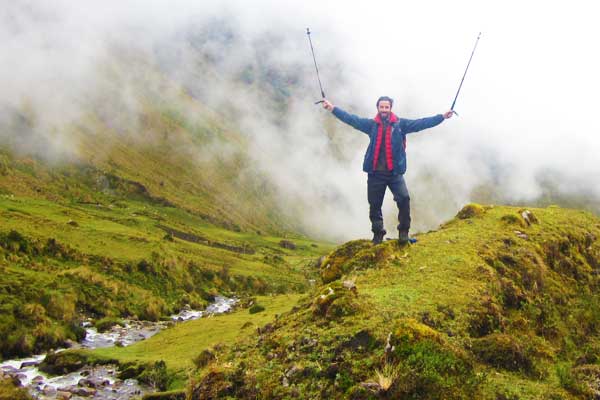What to pack for your Machu Picchu adventure? Here is a detailed list of our recommendations for equipment and gear for the Inca Trail. Some of the key things to consider when you are buying equipment are the season that you will be hiking the Inca Trail to Machu Picchu and the duration of your hike.
This article contains affiliate links. If you buy something using our links, we might get some money. It won't cost you extra, but will help us keep the site alive!
Inca Trail Packing List for Machu Picchu
Things To Consider
Weather
The weather in the Peruvian Andes is directed by two main seasons, the dry season which lasts from April to late September, and the wet months from October through to March.
The dry season on the Inca trail is crowded with tourists, so we recommend that you plan your trip for the shoulder months of the dry season – late March or early April, or the October/November period.
It is strongly advised that you avoid hiking in the months of December, January and February (the Inca trail is actually closed for restoration in February) and while you can still visit Machu Picchu by train during these months, expect rain at the Citadel.
The daily temperatures in the region are moderate and consistent throughout the year, with the daytime average in the low 20s (Celsius) and the average night time temperatures around 5°C.
It is, however, not uncommon for temperatures to drop below freezing during the evening, so it is important to be prepared for a range of temperatures whatever time of the year you plan on hiking. Below are weather charts that show the weather that can be expected all year round, although we advise you to pack with rain in mind even if you are hiking in the dry season.
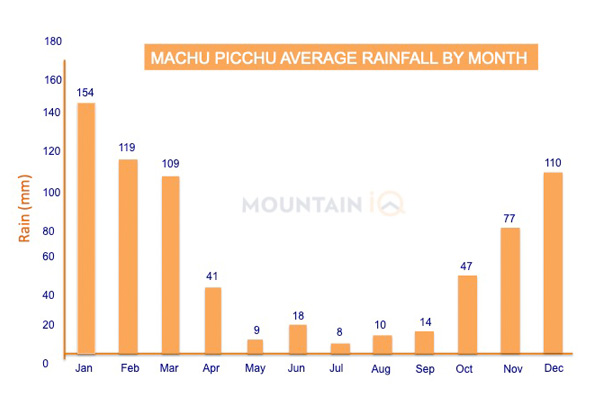
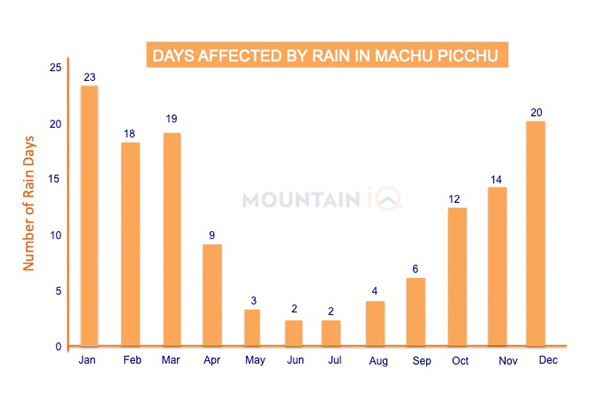
Even in the driest months of May, Jun, and July it is still possible to encounter a rainy day. It is important to pack with this possibility in mind so as not to be caught out in the rain without any protection. Please note: While the temperatures are relatively moderate in the day time, they are known to have fallen to freezing at all times of the year.
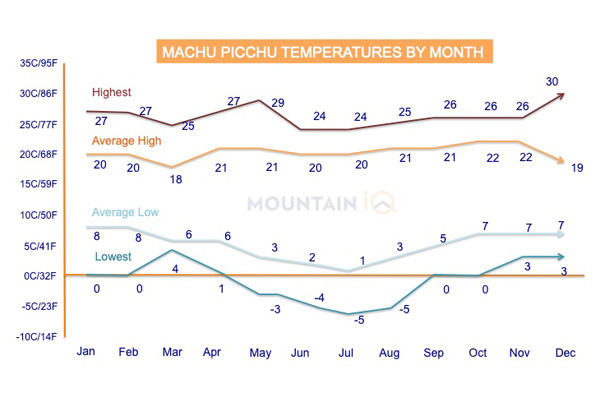
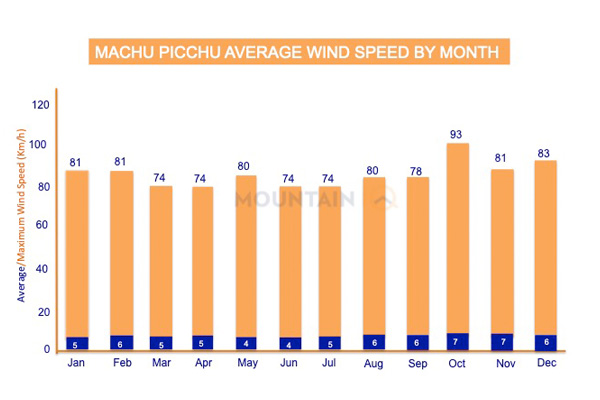
Length and Type of Trek
While this list caters specifically for the Inca trail, other treks to Machu Picchu often require a very similar packing list. Most of the items will therefore carry over, but make sure to compare the number of days you have planned to hike with the 3 to 4-day itinerary of the classic Inca trail.
Of course, if you plan to stay longer you will have to increase the number of hiking trousers, shirts, underwear and socks that you take along. Similarly, compare the conditions of the Inca trail with the alternative trek you have chosen, to make sure there are no additional pieces of equipment that you need. For example, if the trek is known to present a high volume of mud, it is often helpful for hikers to pack gaiters.
Inca Trail Gear List
Clothing
The best philosophy to combat variable weather is by layering. This means that you are able to easily add to your padding if you are at chilly high altitudes, or when you drop into a low shadowed valley, or in preparation for an icy evening, but you can also conveniently remove layers at the peak of the day’s heat.
The most important thing to remember when you are layering, though, is that each layer must allow moisture to pass through it and evaporate off into the air. This ability is largely dependent on the fabric of the clothing. For example, wool is known for its moisture transfer, wicking, properties, while material such as cotton and denim unhelpfully absorb moisture and should not be used. Below we summarise the types of clothing you will need to pack as well as recommendations specific to each.
Base Layer
A base layer is important as a first level of insulation for the cold evenings and misty mornings – you will be eager to remove it as the day heats up. While you will likely only need a top, you may want to also pack a pair of leggings just in case you hit a particularly cold spell.
We suggest you use our recommended base layer clothing manufactured by Smartwool or Icebreaker as they make market-leading lightweight, merino wool products at a good price, but any merino-wool base layer will be fine.
Here are some great quality base layers for Men and Women.
Trekking Shirts
For hiking shirts, we suggest you pack 3 x short sleeved tops, as well 1 x light-weight long-sleeved shirt. The best fabric for your shirt is a breathable, quick-drying merino, polyester or nylon. Make sure to avoid cotton.
Here are some great quality shirts for Men and Women.
Trekking Shorts and Trousers
If your trek is 3 to 4 days long, you will probably need 1-2 pairs of trousers, and potentially an additional pair for hikes longer than 4 days. Recommend brands include Columbia, prAna or Gash Hao.
It is also a good idea to pack a pair of trekking shorts for warm afternoons when full trousers might be uncomfortable during long hikes. You might want to pack a wrap-around sarong or mid-length skirt to allow you to change your base-layers underneath as there is not much privacy in the campsites.
Here are some great quality trekking trousers for Men and Women as well as some great quality trekking shorts for Men and Women.
Breathable Underwear
You will need 3-5 pairs of sports underwear, which can be found at any sports brand like Under Armour or Adidas. Women should choose breathable underwear and sports bras.
Here is some great quality breathable underwear for Men and Women.
Fleece Jacket
On the nippier evenings, you will need to cover up with something a bit warmer. You’ll need to pack a mid-weight fleece, preferably one made of Porlartec material.
Polartec generally comes in grades of 100s, 200s or 300s and Columbia makes great fleece jackets that are typically warm enough for the Inca trail. Although more expensive, one of the best fleeces for Polartec are made by Patagonia.
Alternatively, we also found sleeveless puff jackets and vests useful, like the North Face Acancagua Puffed Vest and the Campshire Sherpa Fleece. They also cost a bit less.
Here are some great quality fleece jackets for Men and Women.
Hard Shell Jacket and Poncho
Over your fleece jacket, you will need to have a weather-resistant layer. This should be relatively light but warm and durable enough to protect you from wind and rain.
You'll still need to pack a basic poncho to keep most of the moisture out. These are cheap and practical.
Here are some great quality hard/wind shell jackets for Men and Women as well as great quality rain ponchos for Men and Women.
Inca Trail Packing List
Headgear
Sunhat
A lightweight, easy-to-fold sunhat is one of the most important items to avoid sunburn and heat stroke. We recommend either a basic trekking hat or an even less flattering one with a neck cover. Don't pack a hat designed as a fashion-item – you will have to squash it up for packing.
Here are some great quality sun hats for Men and Women.
Headband or Bandana
A headband can double as neck-protection from the sun, as well as a scarf and ear-warmer for chilly evenings. They help keep your neck and face protected and prevents particulates entering your throat when you breath.
During the out-of-season winter months (Dec, Jan and Feb), we highly recommend bringing a balaclava or neckband.
Here are some great quality headbands as well as some great quality bandanas for Men and Women.
Fleece Beanie
As extra insulation for your head on the cold nights, a winter fleece beanie is recommended, especially if you haven’t already packed a headband. A warm fleeced beanie or fleeced headband are absolute must-haves. North Face and Berghaus provide good beanies.
Here are some great quality fleece beanies for Men and Women.
Sunglasses
Good sunglasses are necessary because of the UV intensity at high altitudes which causes eye-damage.
Their lenses offer 100% protection from UVA, UVB and UVC and their lenses block 90% of visible light from entering your eyes. Although these features are not strictly necessary in Machu Picchu – you will not suffer the glare from reflection off snow – but a simple pair of Julbos are still a good idea.
For example, mountain sunglasses from Oakley or the Julbo Montebianco Mountain range are good quality and highly versatile sunglasses. Alternatively some cheapos from Duduma could also be ok.
Here are some great quality sunglasses for Men and Women.
Gloves
Lightweight, waterproof, breathable gloves are mandatory to help you on the higher-altitude passes and for the chilly morning and evenings. Look for a pair that is designed for aerobic activity, but with a little extra warmth.
The Thermal Lite Gloves by Pearl Izumi are good and should work when the weather is moderately cold. Ozero and Under Armour also makes great thin gloves.
Please Note: Even if the gloves you buy are marketed as 'waterproof', the hole for your hand leaves enough room for water to enter the glove no matter the properties of the material itself. If there is enough rain, the inside of your gloves will get drenched, which will be seriously inconvenient for the rest of your trip. We advise that you reserve your gloves for chilly, dry mornings and evenings and not wear them during downpours.
Here are some great quality gloves for Men and Women.
Hiking Boots
Footwear
Your hiking boots can make or break your experience. It's crucial that you arrive with a good pair of boots that has already been broken in to avoid a hike plagued with sore feet, blisters or bleeding toes. The most important factors to look out for when purchasing your boots are fit and quality.
How To Choose Your Boots' Fit?
To check if your boots fit properly, first try them on with a mid-weight trekking sock on and push your foot to the front of the shoe. Place your index finger between your heal and the back of the boot – if your finger fits snugly then this is the right shoe fit for you.
How To Qualify Your Boots?
There are a number of things to look out for to determine the quality of a hiking boot:
- Ankle support: medium to high tops are best for ankle support, but are also heavier. We recommend medium high tops
- Weight: mid-weight boots are perfect for Machu Picchu. Although heavier boots are durable and provide a lot of support, they are tiring to lug around.
- Material: the shoe itself should be made of leather or a leather-cordura material. The inner membrane of the shoe should also be waterproof, using a material such as Gore-tex. The soles should be rubber with mid-to-deep lugs for traction.
- Lacing: the lacing pattern should include speed-hooks or D-strings which also provide ankle support.
Some of the best brands for hiking boots are from Salomon, Scarpa, Mishmi and Hi-Tec. For the best boots, check out the Scarpa Kailash, the Salomon X Ultra, Quest or anything from Meindl Ohio for budget boots.
For women, the Columbia Newton Ridge (heavy) and the Newton Ridge (light) could be great options.
Here are some great quality hiking boots for Men and Women.
Sandals for Campsites
After a long day on your feet, you will want to take your hiking boots off as quickly as possible for relief. A simple pair of light-weight sandals will be perfect to air your feet. Alternatively, you could pack a pair of lightweight trainers. Consider the Ecco® Yucatan or KEEN Whisper sneakers.
See our reviews of the best hiking sandals.
Here are some great quality sandals for Men and Women.
Trekking Socks
Bring along 4 pairs of socks – or one for each day of your hike. Light-to-mid weight socks made of high wicking material are perfect. Some options are merino wool, or if you are allergic to wool you can opt for a synthetic acrylic or acrylic-blend sock.
You can also go for a sock which has a waterproof membrane but remember that cotton socks they absorb water and promote the formation of blisters, so they are not ideal for hiking. It is also important that your chosen socks have flat seams which prevent blistering.
The sock brands which could work well for your hiking needs include MIRMARU, Danish Endurance or any socks from Smartwool.
Here are some great quality trekking socks for Men and Women.
Gaiters (optional)
Gaiters are zipped over your lower leg, covering the top of your hiking boot to prevent mud, water, pebbles, dust and grit from entering your boots. These are not usually necessary as most trails on the way to Machu Picchu are heavily trodden. Still, gaiters may come in handy if you are hiking in a particularly rainy season, as the mud can be irritating to trudge through.
Here are some great quality gaiters for Men and Women.
Trekking Equipment
Trekking Poles
Walking or trekking poles are essential to saving your knees on the thousands of steps you will be climbing up and down. We find that the best value for money foldable trekking poles are from TYTN, a small brand for hikers.
With the help of trekking poles, the shock to your joints will be reduced by 25% - even higher according to a 1999 study published by the Journal of Sports Medicine.
Poles also help to improve your balance on the trail, minimising the risk of a nasty fall.
The following should be taken into account when purchasing trekking poles:
- Lightweight: 250 – 350 g/pole
- Adjustability: a lever-locking mechanism is preferred to a twist-locking mechanism
- Material should be aluminium of carbon fibre (avoid steel)
- Water-resistant, ergonomic grip (ideally made of cork)
Depending on the kind of money you want to spend on your poles, there are a range of options.
You'd need adjustable light-weight trekking poles (around 350 grams per pair) that are easy to store, durable and versatile.
Alternatively, if you have more budget, our favourites are the Black Diamond Alpine Carbon Cork or Leki Micro Vario.
Here are some great quality trekking poles for Men and Women.
Headlamp
A headlamp/torch will be used when you are walking around the campsite and preparing for bed in the evenings. You may need it on the trail if you are up before sunrise, and if you lag and reach the campsite after dusk has fallen.
Petzl is the leading producer of head torches, and we suggest getting either the REACTIK or Tikka (their budget option).
Here are some great quality headlamps.
Bags
Duffel Bag
The bag that you bring is highly dependent on the support team that you have accompanying you. On the Inca trail, it is common for trekkers to carry their own gear, while porters will carry camping materials like you tent and food.
If you have the extra cash, some people hire a porter who will carry 7-14kgs of your personal gear as well. On some of the alternatitve hikes to Machu Picchu it is common for companies to use pack animals (mules or llamas) to carry around 5kg of your gear.
When you arrive in Cusco, you will separate your hiking gear from the rest of your travel kit. You will typically leave the surplus clothes in your hotel, so it is important that you either pack a small duffel bag or simply use your main travel suitcase and pack your hiking backpack inside that.
If you have porters, it is important that you separate the gear that you will need during the day from the items that you don’t need that the porters will be able to carry straight to the next campsite for you.
Every day, you will be wearing a total of about 3-5kg of kit. This means that you will have to carry about 3kg of gear yourself, as well as 2-3kg for snacks and water.
Overall, most people keep their daypack below 10kgs. If you are trekking without porters, you will need to be conservative with the weight of kit you bring. Try to keep your total kit below 15kg (including the 3-5kg of kit you will be wearing).
Here are some great quality duffle bags.
Backpack, Daypack and Dry Bag
When looking at backpacks, one of the key features is the ability of the bag to transfer most of the weight onto the trekkers hips. Your shoulders should support no more than 30 % of the total weight. Critical features of a good backpack include:
- Size: typically, the ideal size for an Inca Trail backpack is 30-35L, which will easily be able to carry your load of 10kg. If you are not planning on hiring a personal porter, you will need to bring a 40-50L backpack.
- Weather-resistance: Although backpacks are not generally waterproof, it is important that they are at least “weather resistant”. Good materials are also important and we recommend pack cloth for the bag and Condura for the areas that experience high friction. To waterproof your bag, you will need to pack urethane coating.
- Design: The harness system should be size-adjustable, the shoulder straps padded and allow for movement, and the hip belt should also be well padded. Some of the best brands manufacture bags specifically suited for feminine body shapes.
Here are some great quality backpacks for Men and Women.
For a good unisex daypack, we suggest the Osprey Talon 33 or the Osprey Talon 22". Another option is the North Face Casimir 32 for men and the North Face Casimir 27 for women.
Finally, you may want to bring along a 30L dry bag, such as the Duc-Kit Pro. These are super waterproof and especially helpful for a porter to transport your personal items in.
Here are some great quality daypacks for Men and Women as well some great quality dry bags.
Water Bottles or Hydration Packs
One of the main tips to avoid altitude sickness is to stay well hydrated throughout your trek. On the trek, you should drink 2-3L of water per day. Although your touring company should take care to provide you with clean water, you might want to bring some water-purification tablets or Isotonic powder along as an added precaution and to make the water taste better.
To carry your daily water, you can bring along two 1L bottles or use a hydration bladder that holds 2-3L. Some of our favourite products are the CamelBak Eddy 1L or, if your daypack includes space for a hydration bladder (the Osprey Talons do), the 2L Platypus Big Zip Water Reservoir.
Here are some great quality hydration bladders as well as some great quality water purification tablets.
Inca Trail Sleeping Gear
Sleeping Accessories
Sleeping Bag
It is possible to rent a sleeping bag in Cusco, but we advise against it due to their dubious hygiene standards and problematic quality.
If you still decide to rent a sleeping bag, make sure to bring a sleeping bag liner from home and follow the guidelines below to make sure your bag is reasonably reliable. Consider the Sea to Summit Thermolite.
A good quality sleeping bag is just as important as good hiking shoes. The following are the key characteristics to keep in mind when buying or borrowing your sleeping bag for Machu Picchu:
- Goose or duck down vs synthetic: down sleeping bags are lighter and warmer but are more expensive than the synthetic alternative. To choose between the two options consider whether you are likely to reuse your sleeping bag in the future. If you are planning on camping in high altitudes again, on treks like Mount Kilimanjaro or Annapurna Circuit, then purchasing a down sleeping bag is definitely a worthwhile investment. If your hike to Machu Picchu is likely to be your only camping adventure, then a synthetic sleeping bag is good enough.
- Warmth: Night times get pretty cold in Machu Picchu all year round, so we suggest that you get a 4-season bag with a rating of -10 (C.
- Weight: the heavier your sleeping bag, the warmer it is. To optimise this trade-off, we recommend that you get a bag of no more than 2.5 kg.
- Shape: look for a sleeping bag that is a mummy shape, preferably with an insulated hood and a draw string.
Here are some great quality sleeping bags for Men and Women as well as some great quality sleeping bag liners.
Insulated Sleeping Mat (Optional)
While basic sleeping mats are generally provided by tour operators, you might want to bring along a lightweight sleeping mat for extra comfort and insulation
Here are some great quality sleeping pads.
Inflatable Pillow (Optional)
If you don’t feel like using spare clothing to rest your head on, it might be a good idea for you to pack an inflatable pillow to rest your head.
Here are some great quality inflatable pillows.
Personal Items & Other Accessories
Permit - This is the first thing you need to procure for your hiking trip to Peru. It is fairly important because you won't be able to enter Machu Picchu without a permit.
Passport – you need it to enter the Inca trail and Machu Picchu. Bring a few certified copies too just in case.
Insurance – travel and trekking insurance is required by most trekking companies, and we highly recommend taking it out before your trip. Remember to write down and bring down your policy number, as well as a copy of the policy you have signed up for just in case.
Small Locks – To protect your belongings in your backpack or duffle bag.
Here are some great quality travel locks.
Trekking towels - This might be of use after a rainy (or sweaty) day on the mountain to dry off. You might also have the option to shower in one of the campsites, so a towel will come in handy.
Here are some great quality trekking towels.
Swimsuit (optional) – For the hot springs near Aguas Calientes, just below Machu Picchu, where you can enjoy a well-deserved dip.
Here are some great quality swimsuits for Men and Women.
Umbrella (optional) - can be really useful if you encounter a light drizzle. You may want to avoid putting on your full waterproof kit, so an umbrella is a helpful precursor.
Here are some great quality umbrellas.
Sunblock - Sweat-resistant sunblock is crucial to a successful hike. Make sure that you get one with an SPF of higher than 30, and that the product is sweat-resistant. P20 is known as the best option for any athlete. Bring along lip-protecting sunblock too.
Here are some great quality sunscreens and lip balms.
Insect repellent - necessary to ward off irritating flies and mosquitoes. Reliable brands with a Deet content of at least 90% are best. Although Cusco is considered a low-risk malaria area, it is better to be safe than sorry.
Here are some great quality insect repellents.
Wet Wipes – Perfect for a quick wipe down after a long day’s exercise, and helpful to freshen up. Also bring hand-sanitizer to clean your hands before meals.
Here are some great quality wet wipes.
Waterproof Ziplock/stasher bags - they come in a variety of sizes for you to separate your wet and dry clothing. Bring small zip lock bags for your valuables such as your camera, money and passport.
Here are some great quality ziplock/stasher bags.
Pee funnel (optional) – Many women might find a pee bottle difficult to use on a trek, men can of course also bring one along for convenience. Freshette has some great options for pee bottles for men and pee funnels for women.
Here are some great quality peeing accessories.
Blister plasters - great for pain relief on long treks over rough terrain.
Here are some great quality blister treatment packs.
General Medication – Bring along a Paracetamol based pain killer to ward off early headaches due to altitude sickness. Your guide should also bring along a first aid kit.
Snacks – Bring along about 2 energy bars for each day on the trail, as well as other healthy energy foods such as raw nuts.
Here are some great quality energy bars.
Toiletries – In addition to the toiletry standards (toothbrush, toothpaste, travel soap etc), make sure to pack a roll of toilet paper for your hike.
Here are some great quality toiletry bags.
Cash – Bring along cash in US dollars for tips and in Soles for small mementos and access to toilets in Machu Picchu. The tips should amount to about ($5/day for porters per trekker, and $20/day for guides per trekker).
Here are some great quality travel wallets.
Book or Kindle – Machu Picchu reading material will really add to your overall experience. Some our best recommendations include The White Rock by Hugh Thomas which gives a great background about the search for the Lost City. The Footprints Cusco & Inca Heartland Guidebook also provides a brilliant overview of the history of the region.
Camera - cameras make these once-in-a-lifetime memories last. Some good options are given here, or you can bring along a GoPro Hero if you are worried about packing too heavily. Remember to bring along everything fully charged as there will be no charging points on the trail.
Inflatable Kayak - If you find yourself in hiking terrain where there's open water (weather permitting), bringing an inflatable kayak along can be a worthwhile adventure during the daytime.
FAQ
If you have any further questions or queries about this Inca Trail Packing List for Machu Picchu, then please leave a comment below and we'll respond as soon as possible.
Continue Browsing
For more packing lists see our hiking resources page or choose from one of our popular gear lists below:
